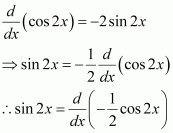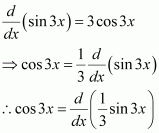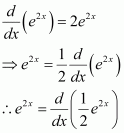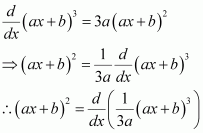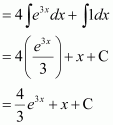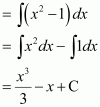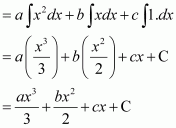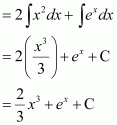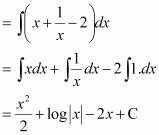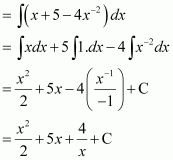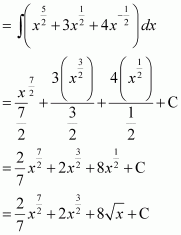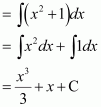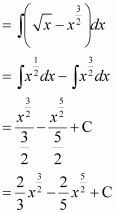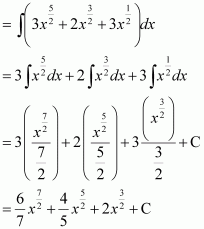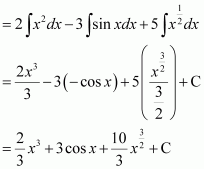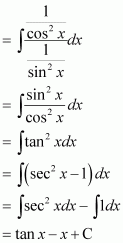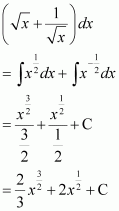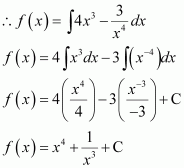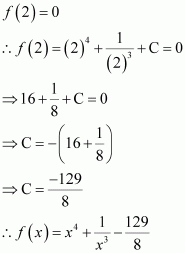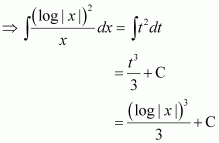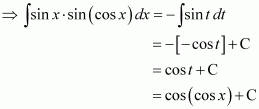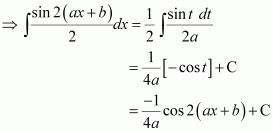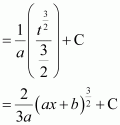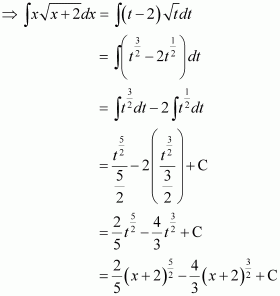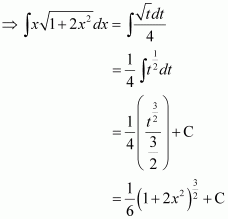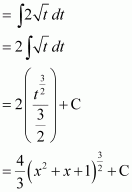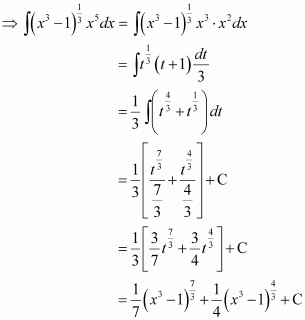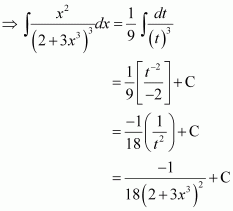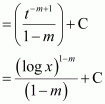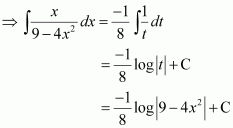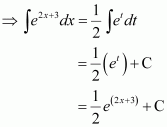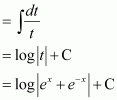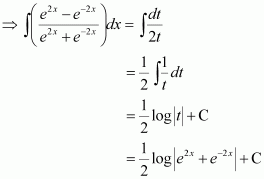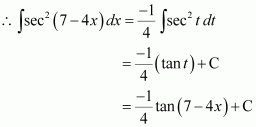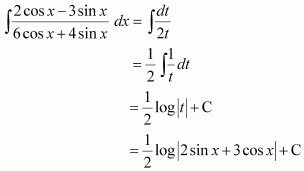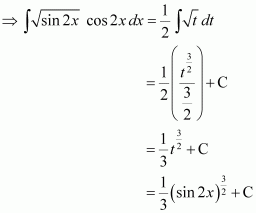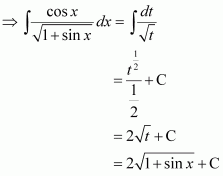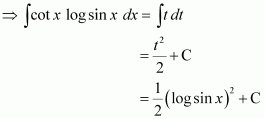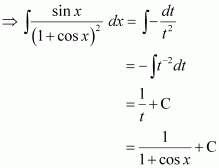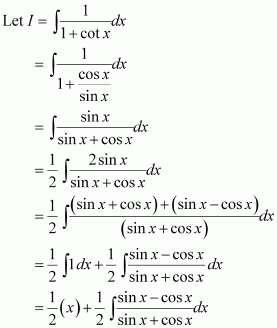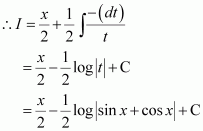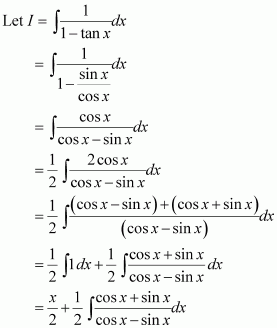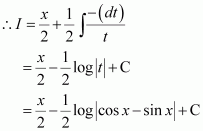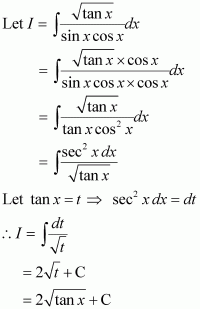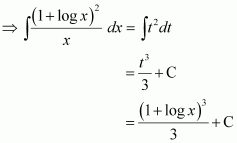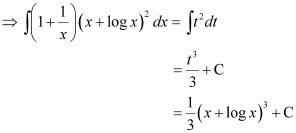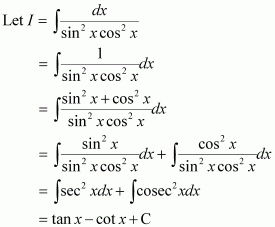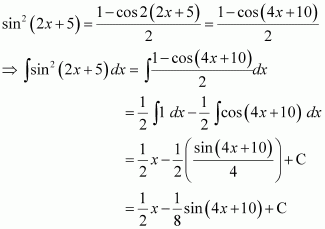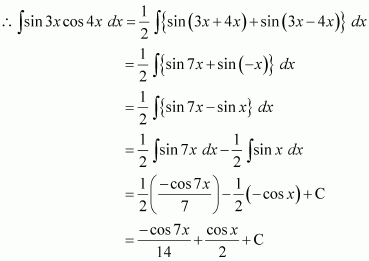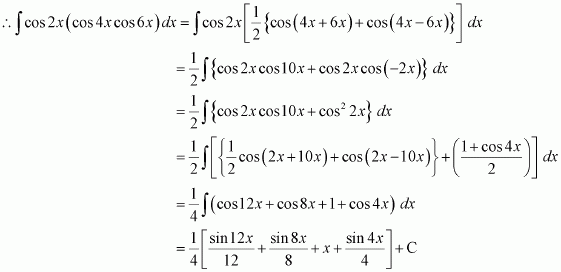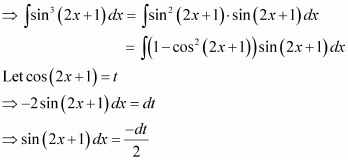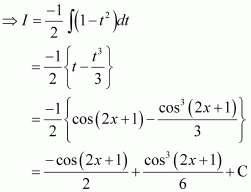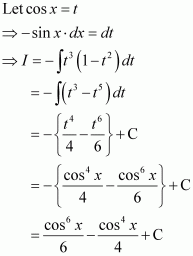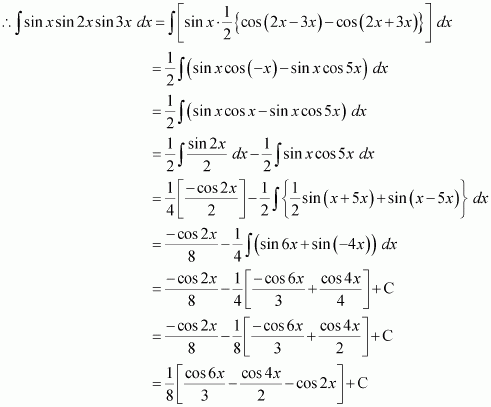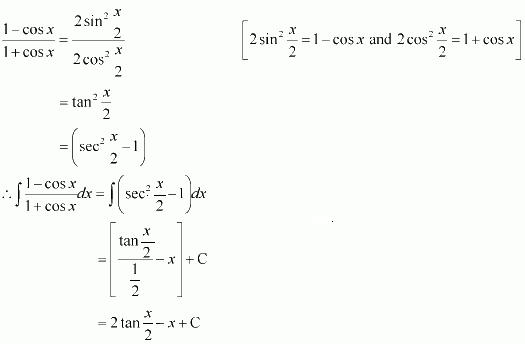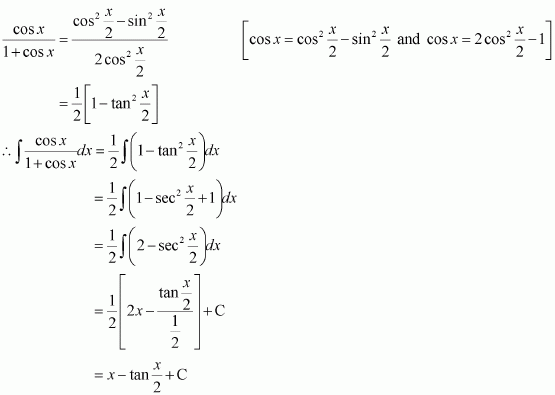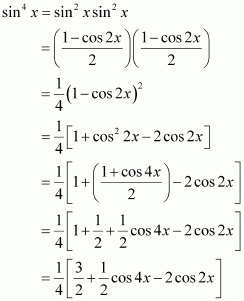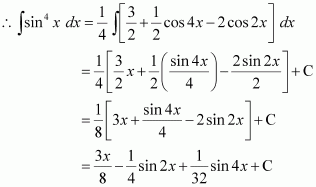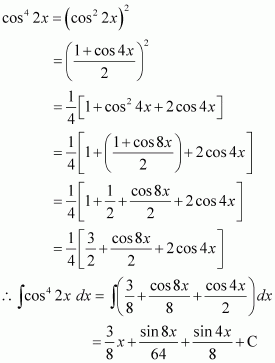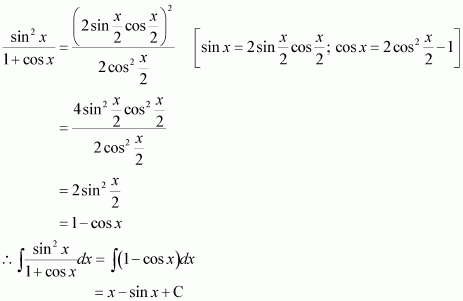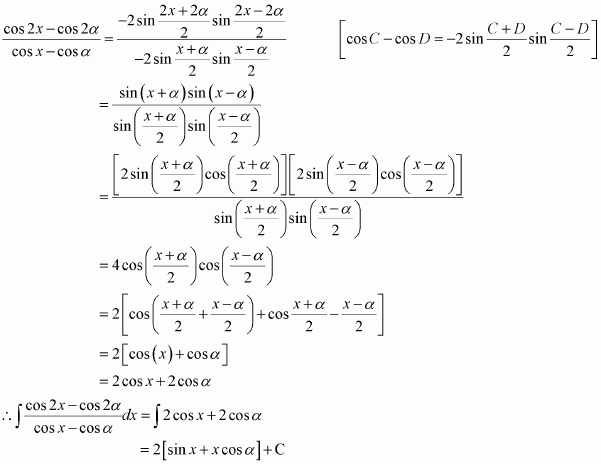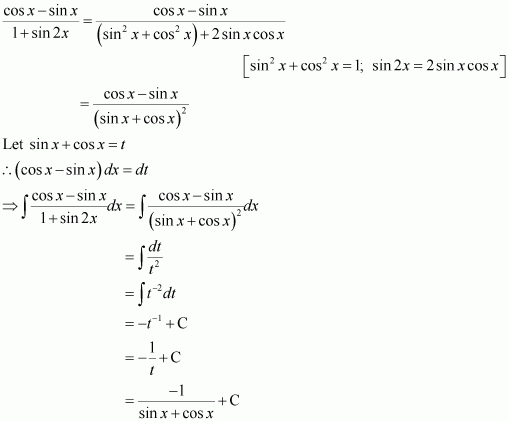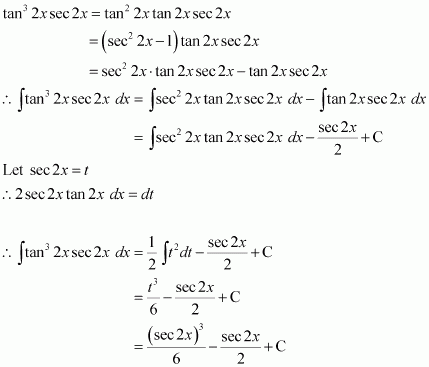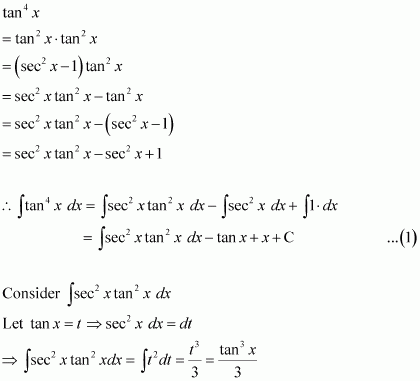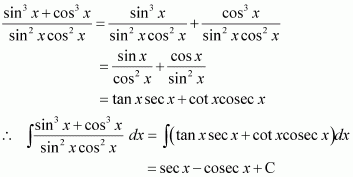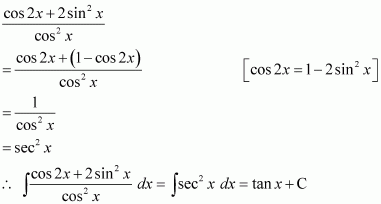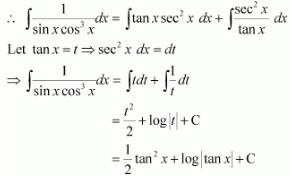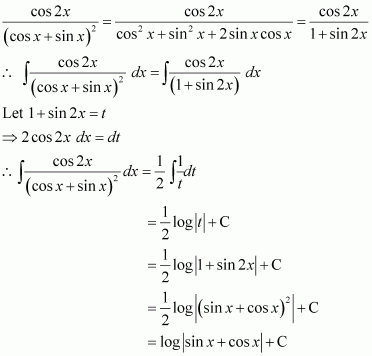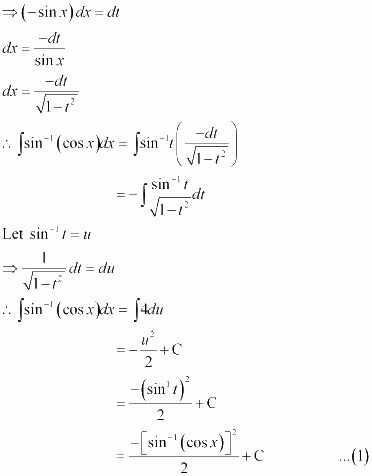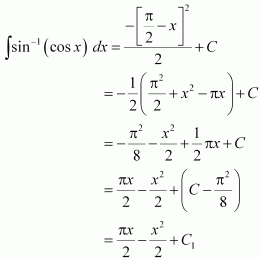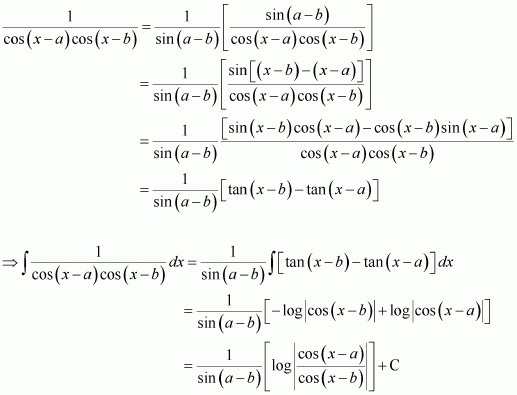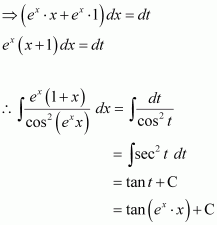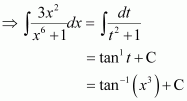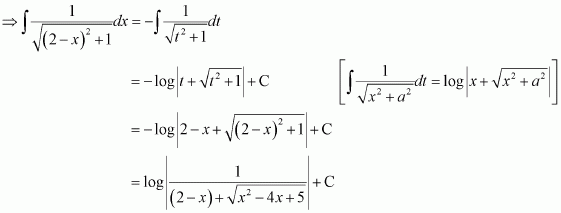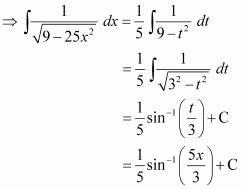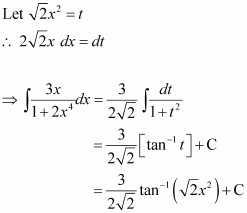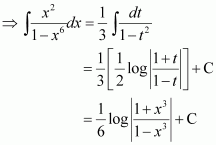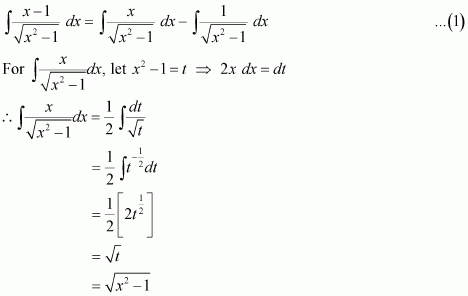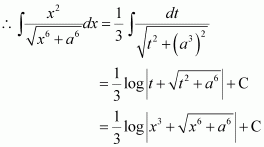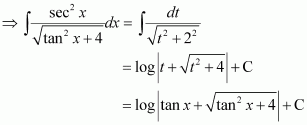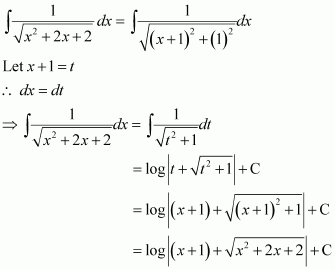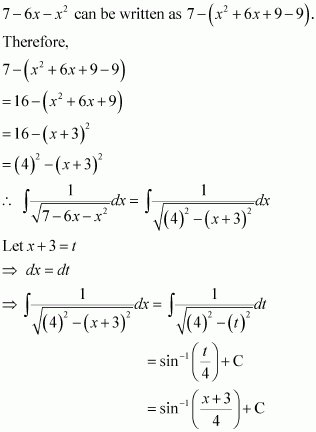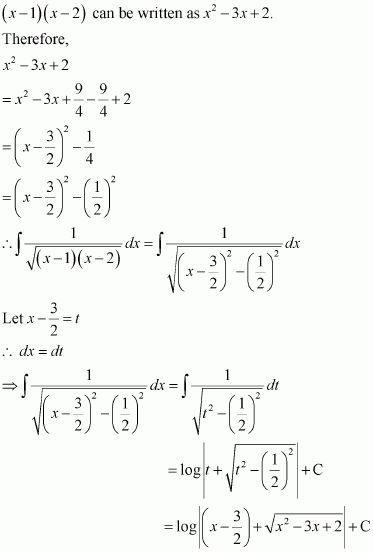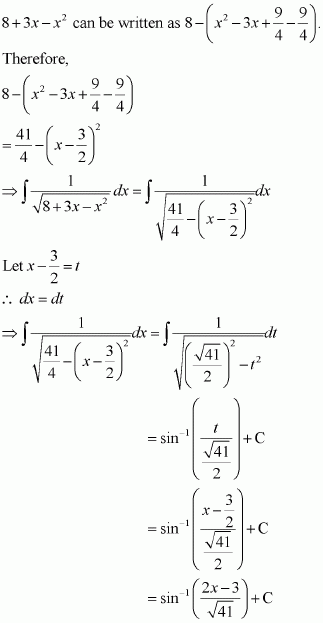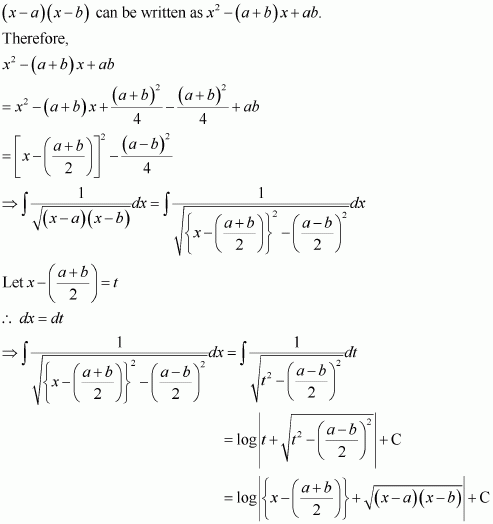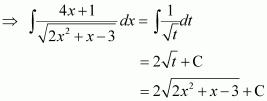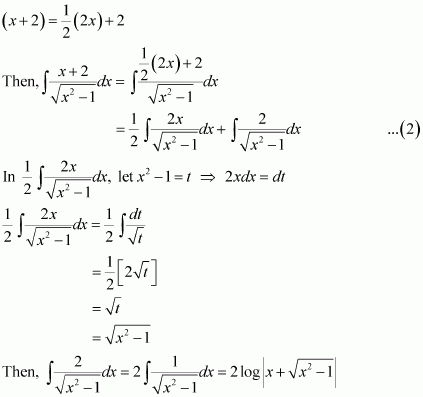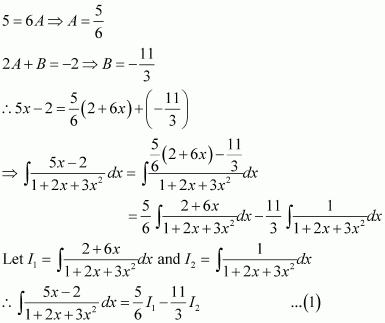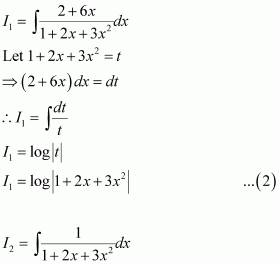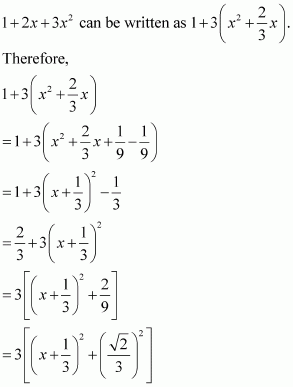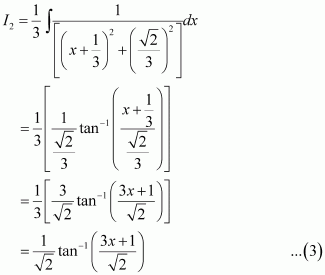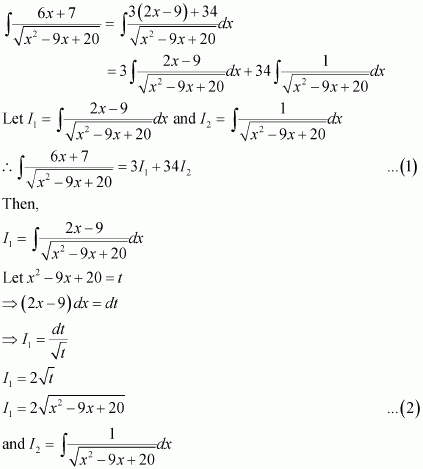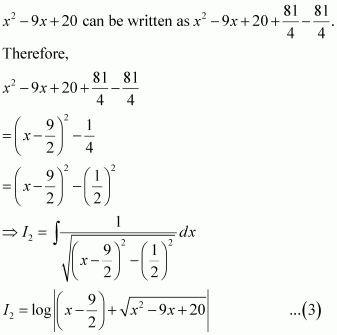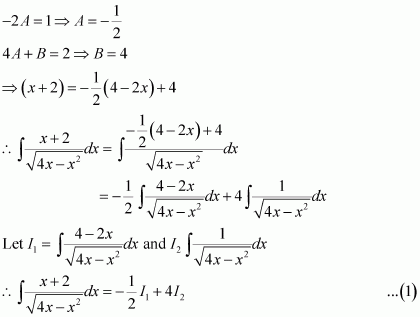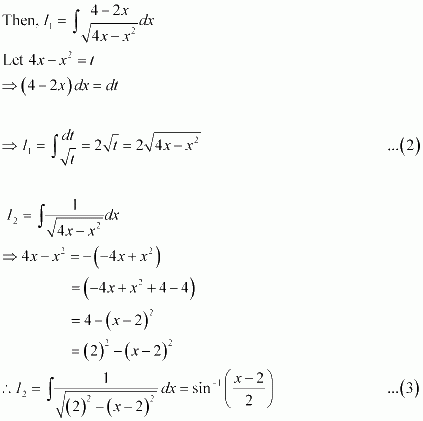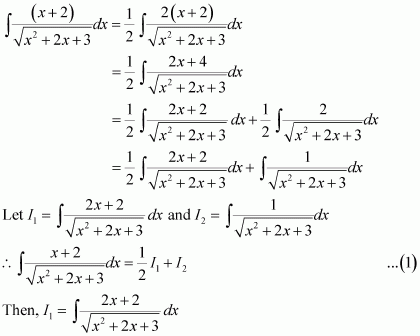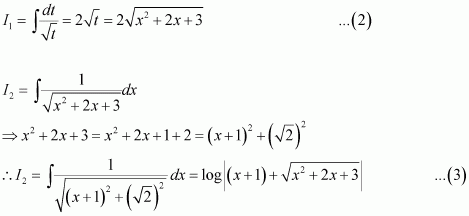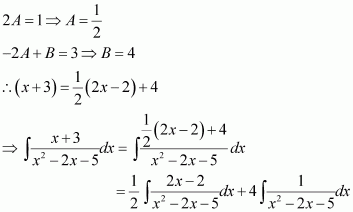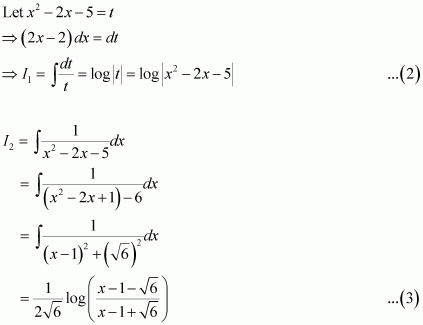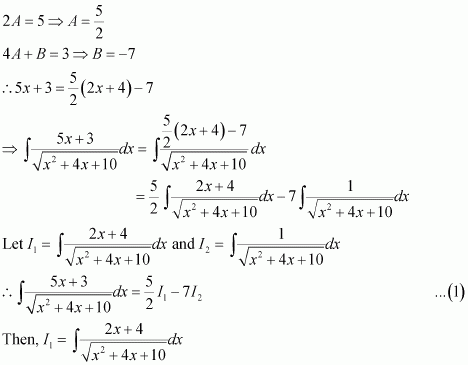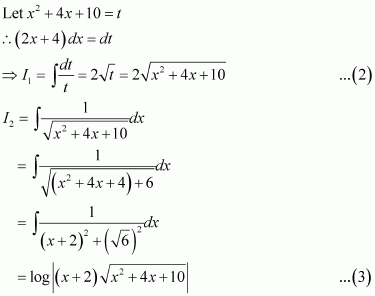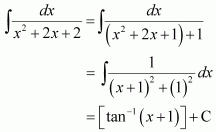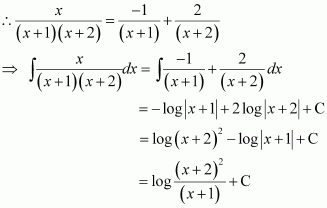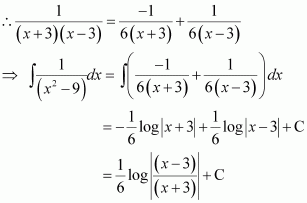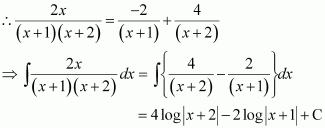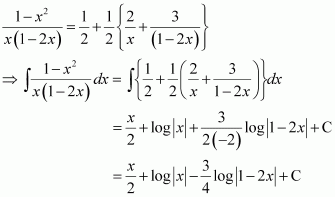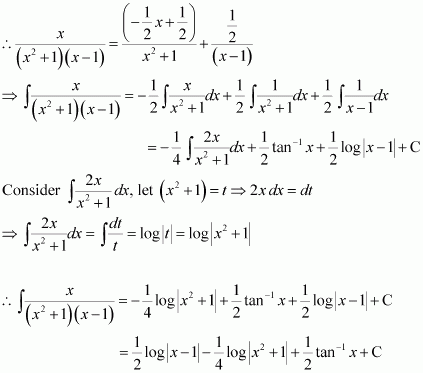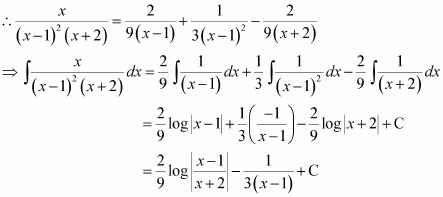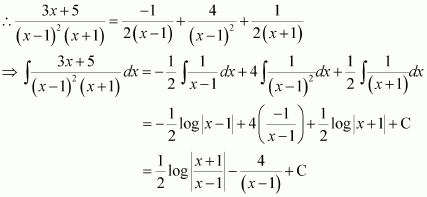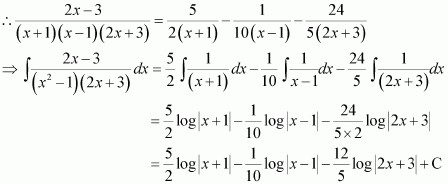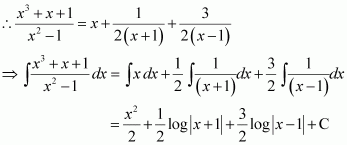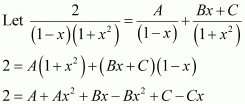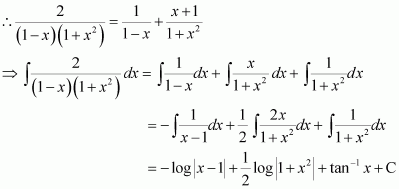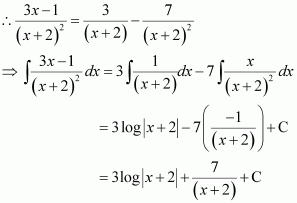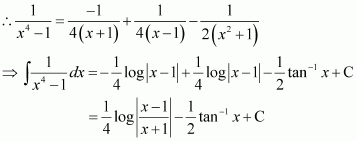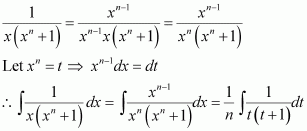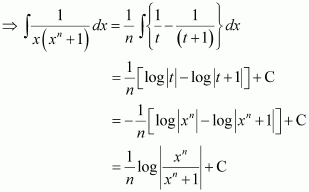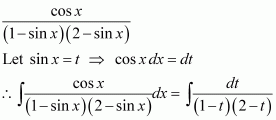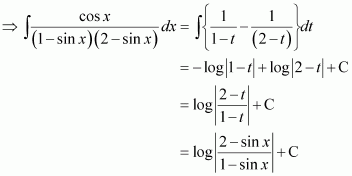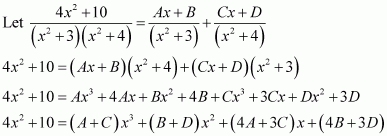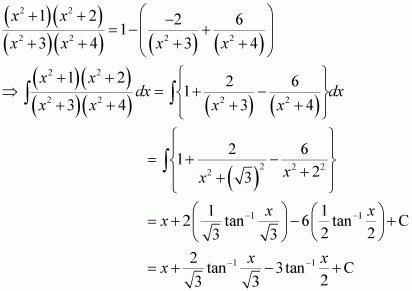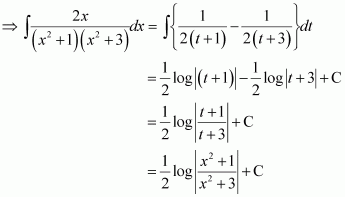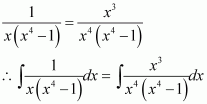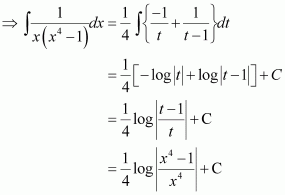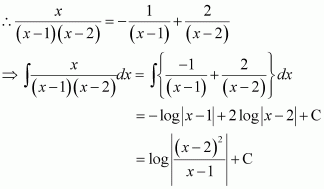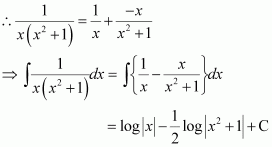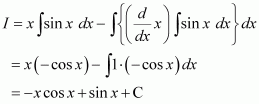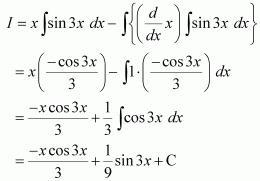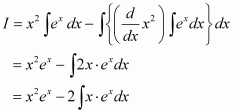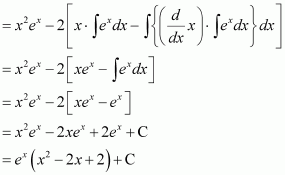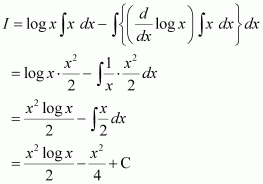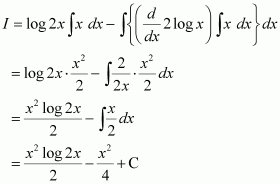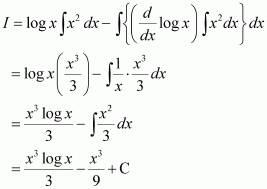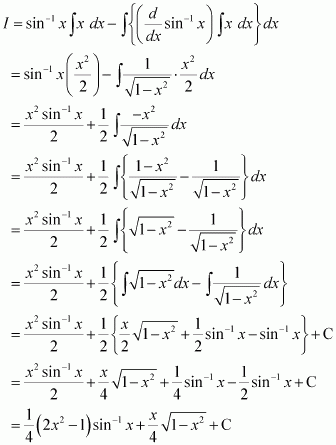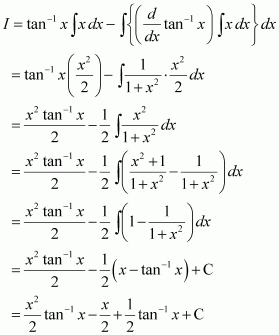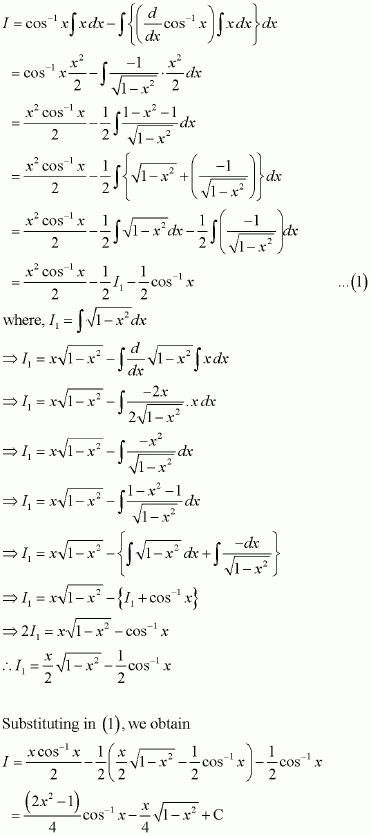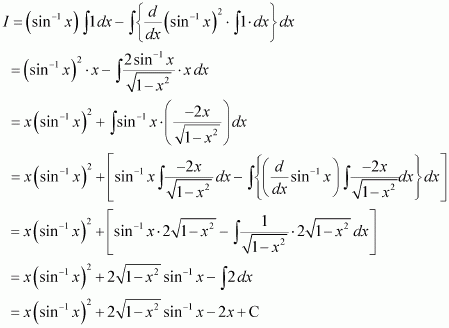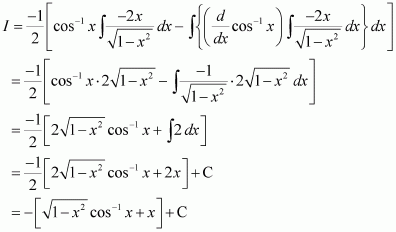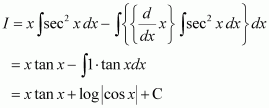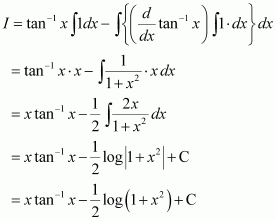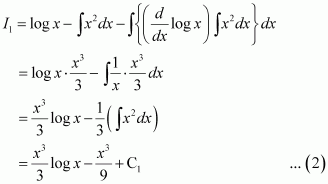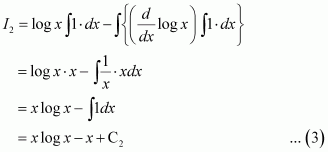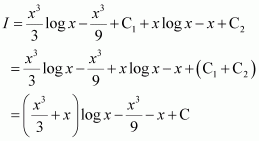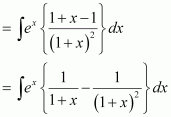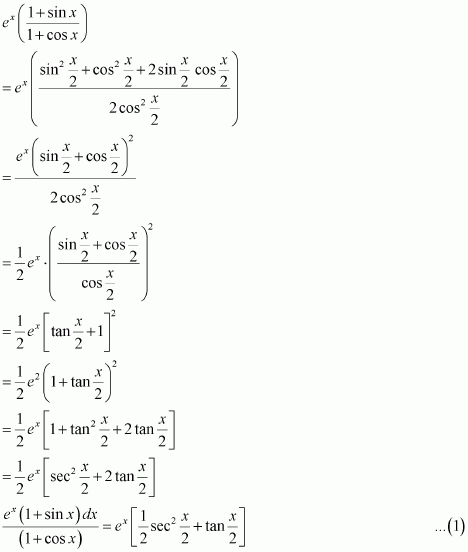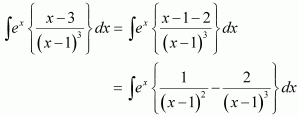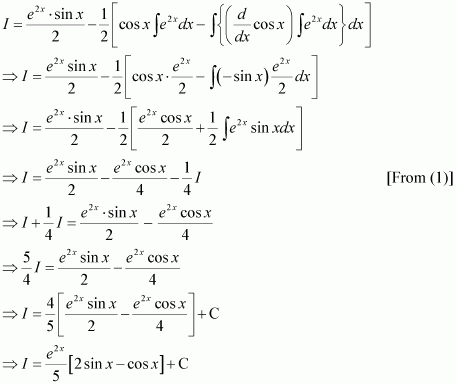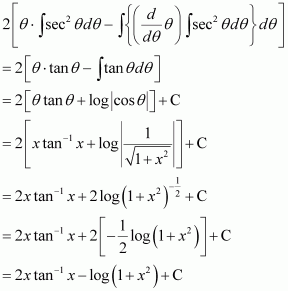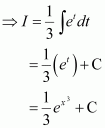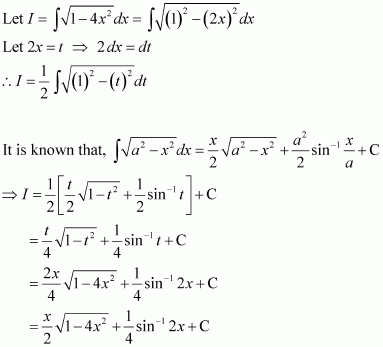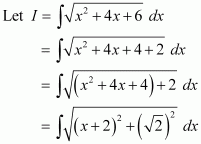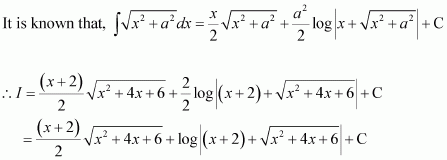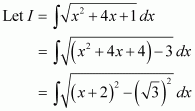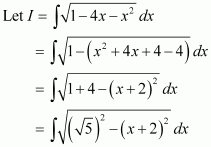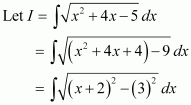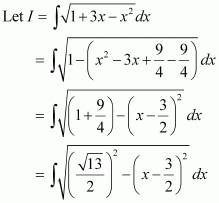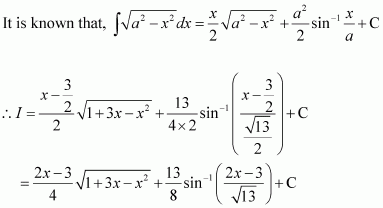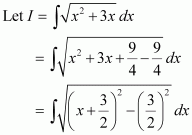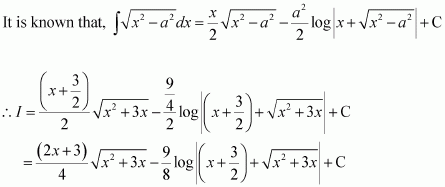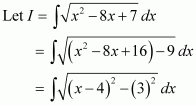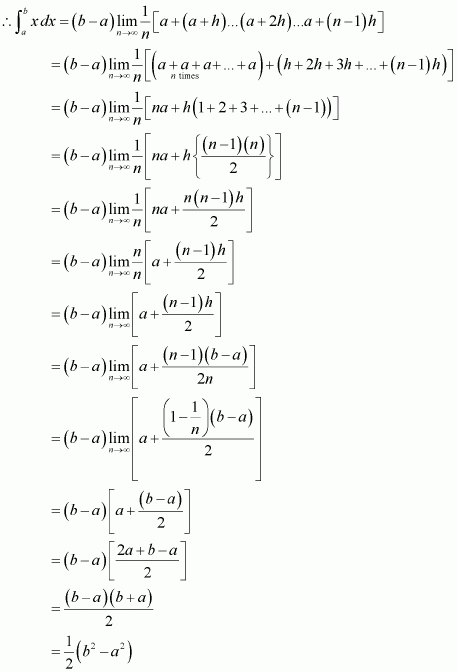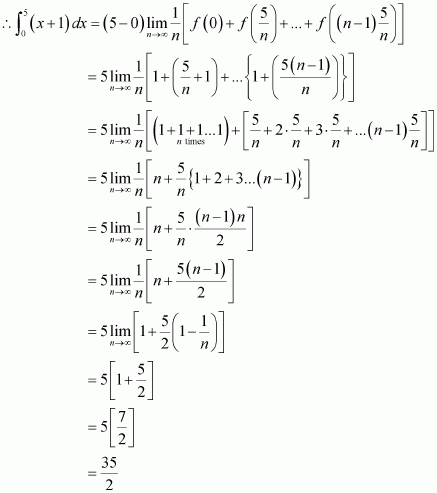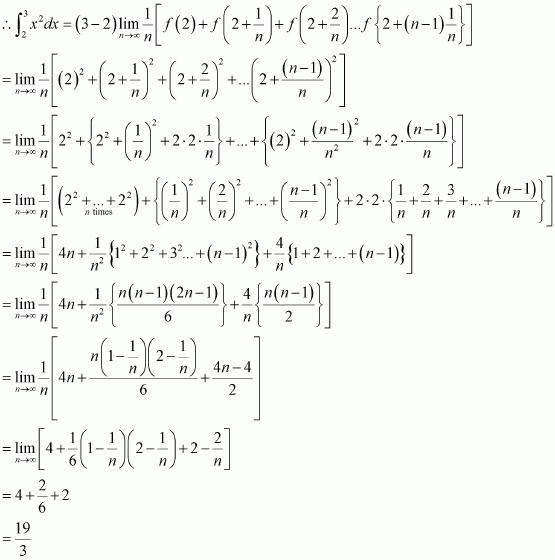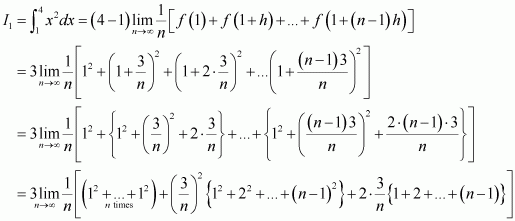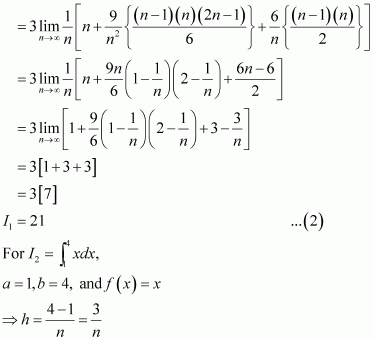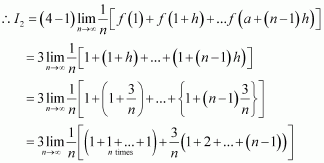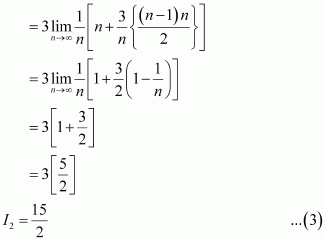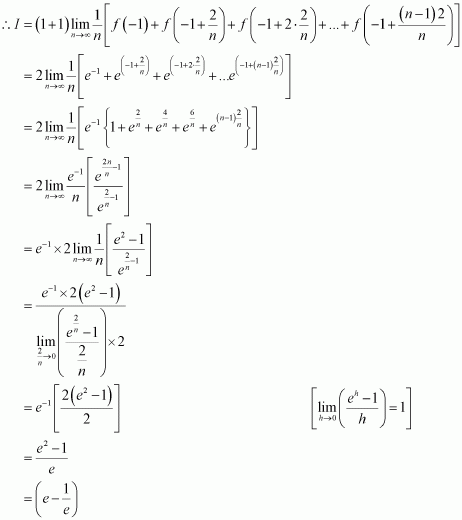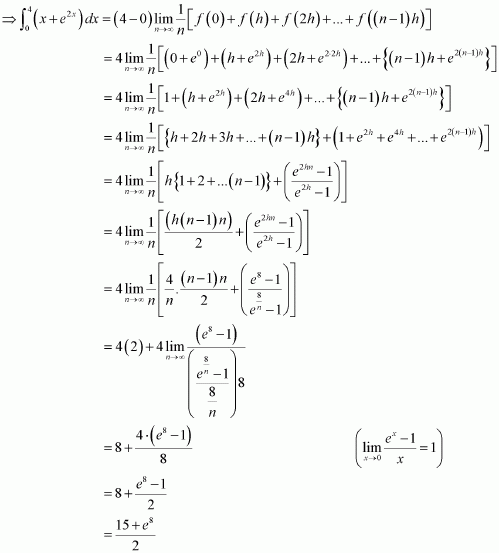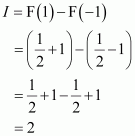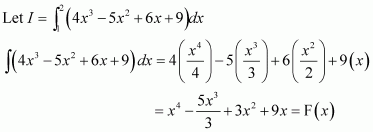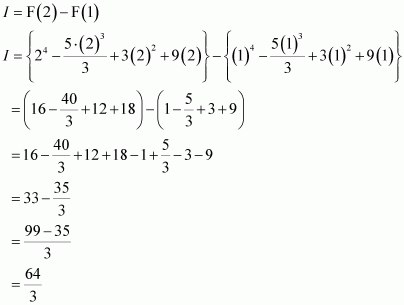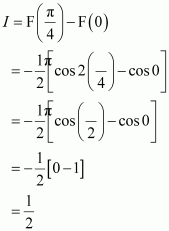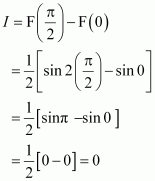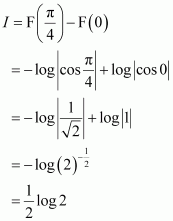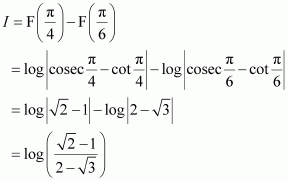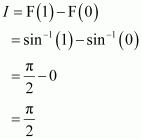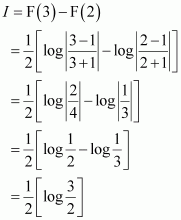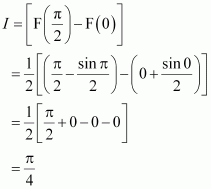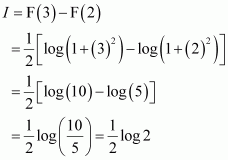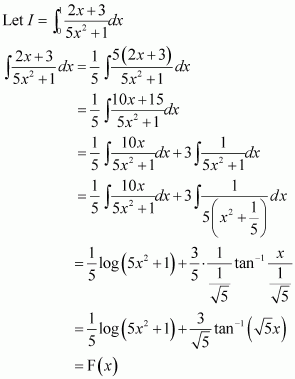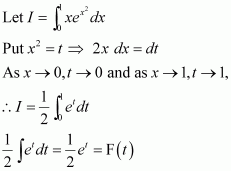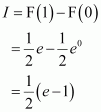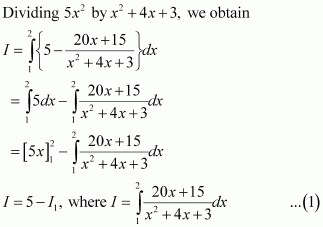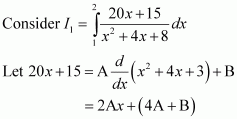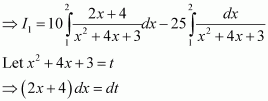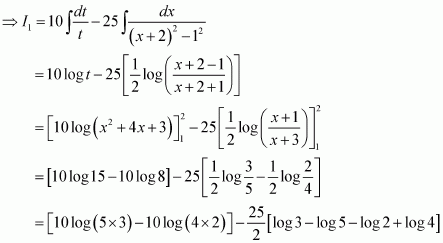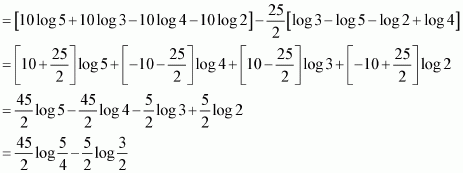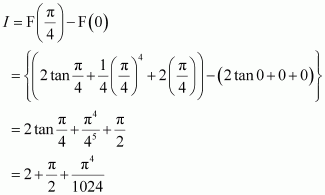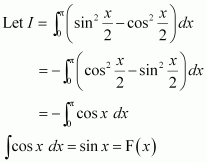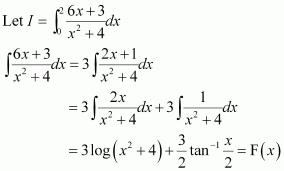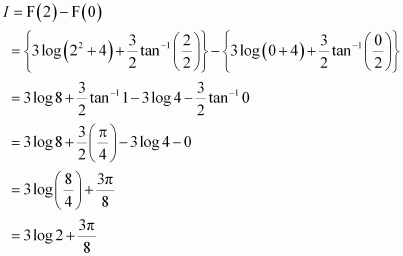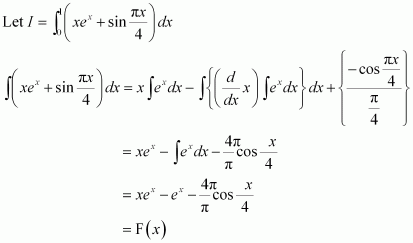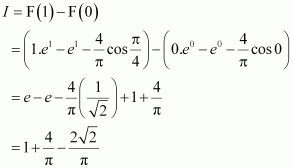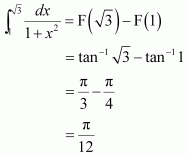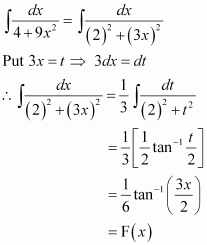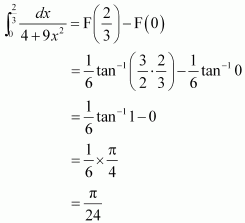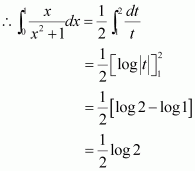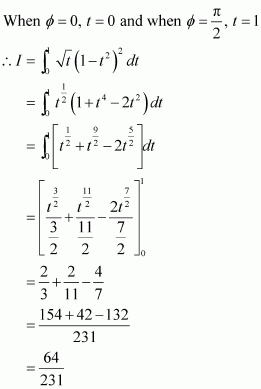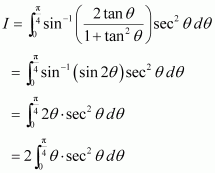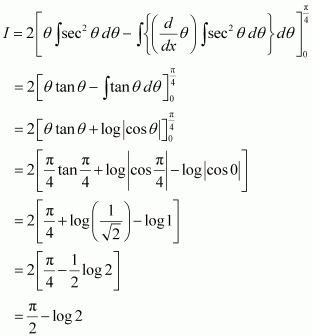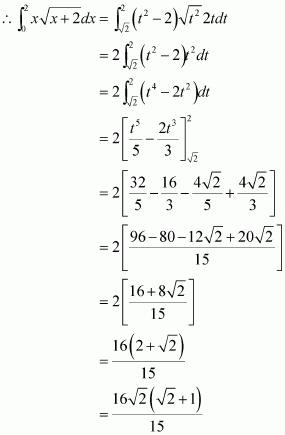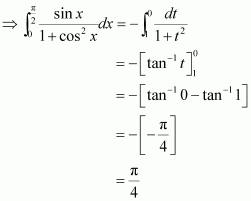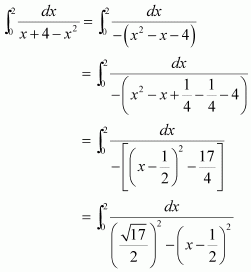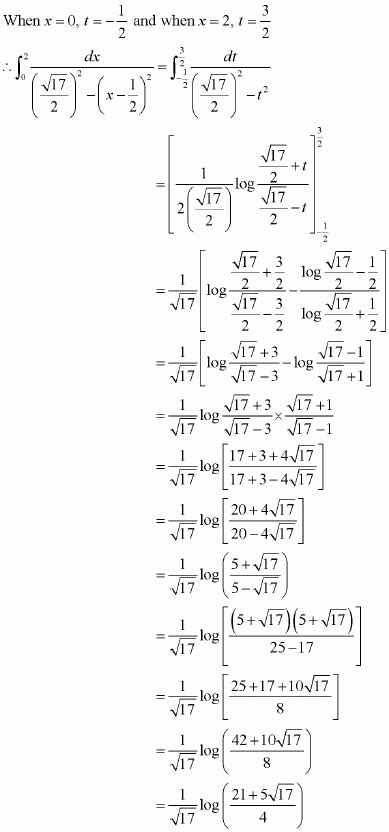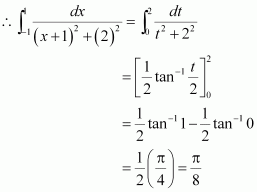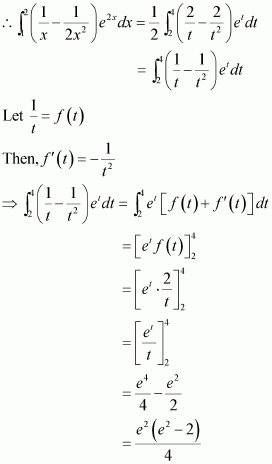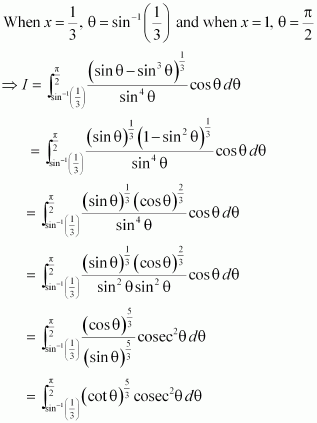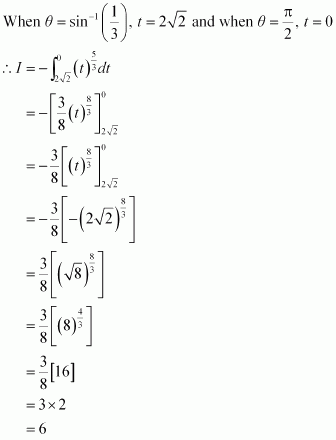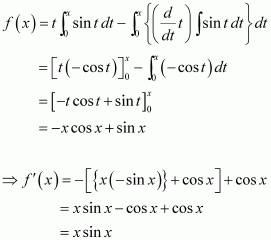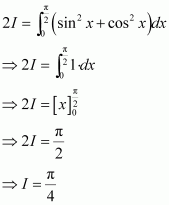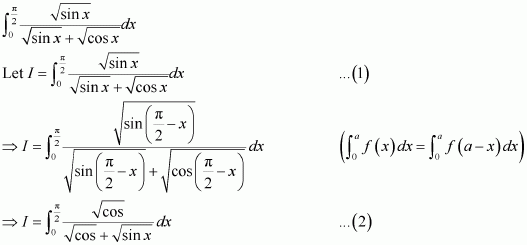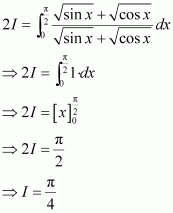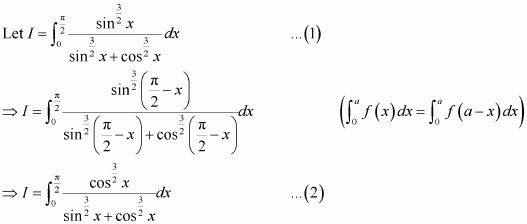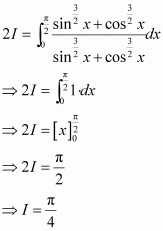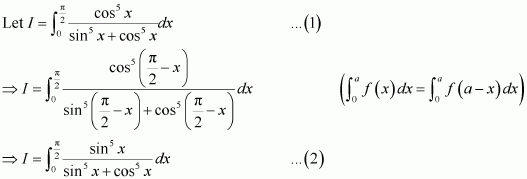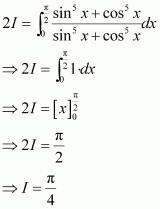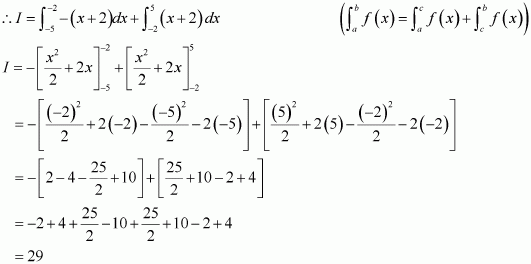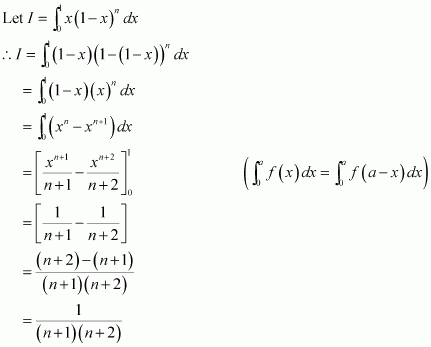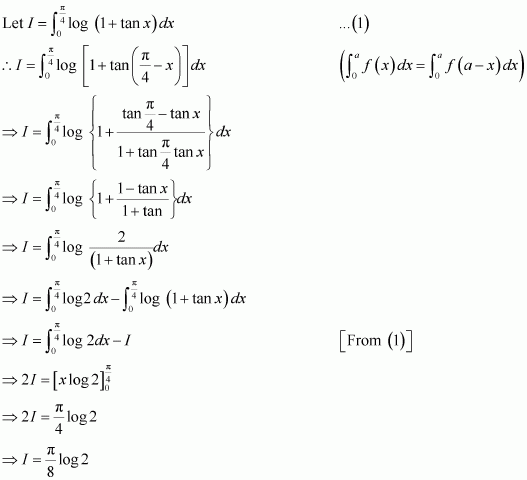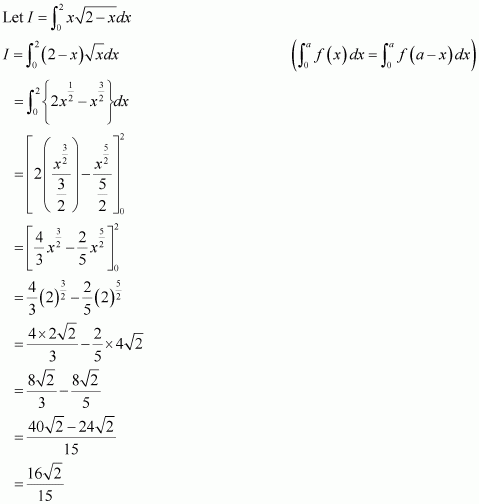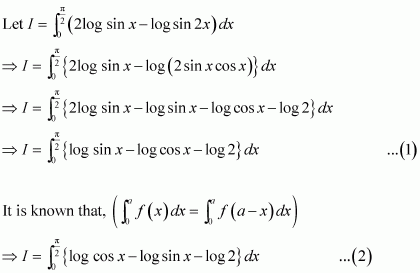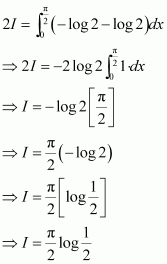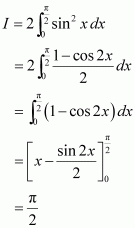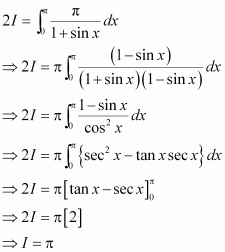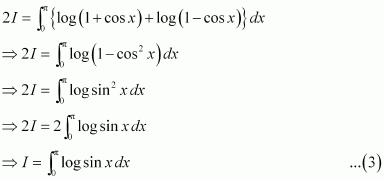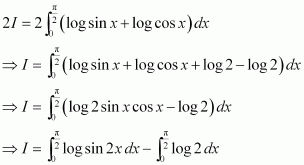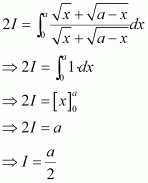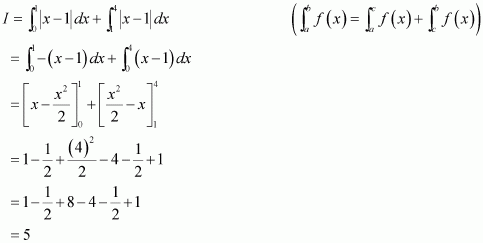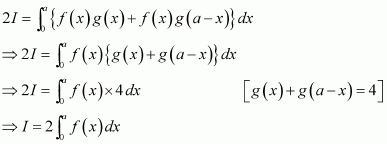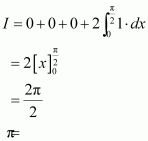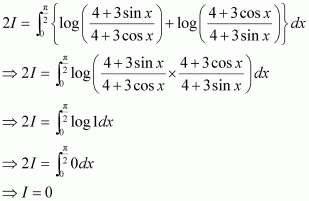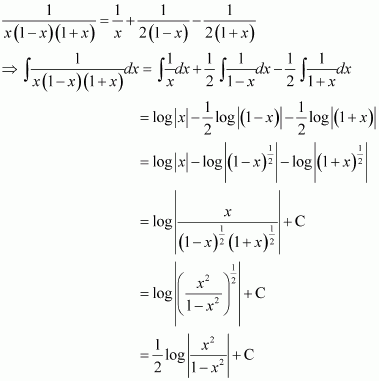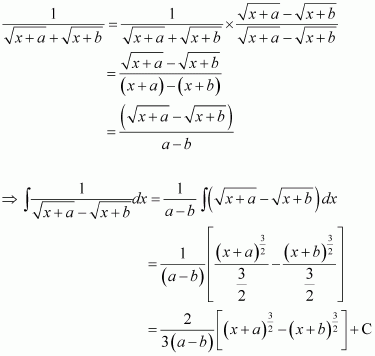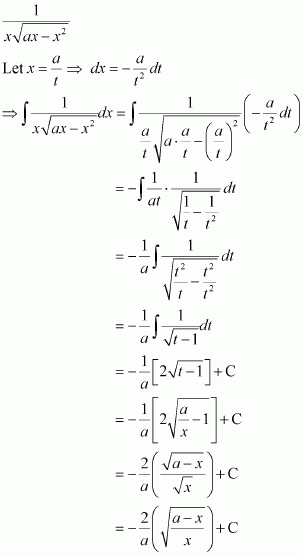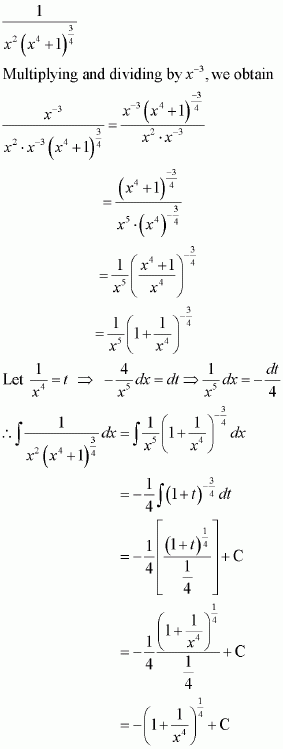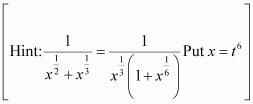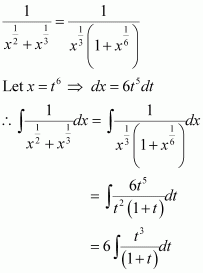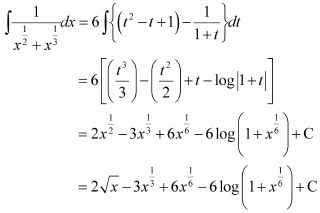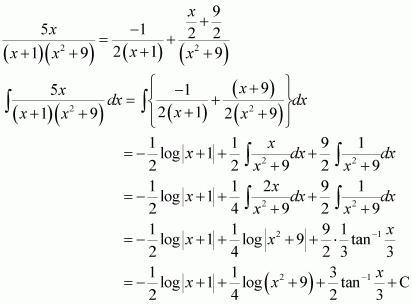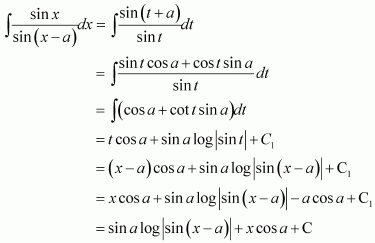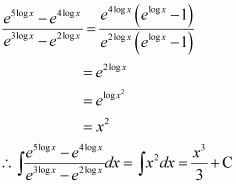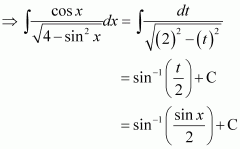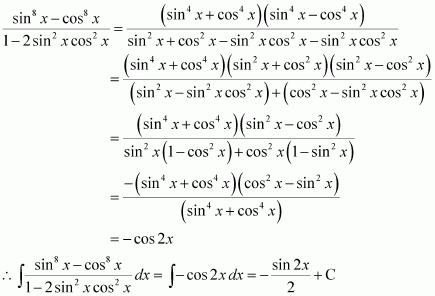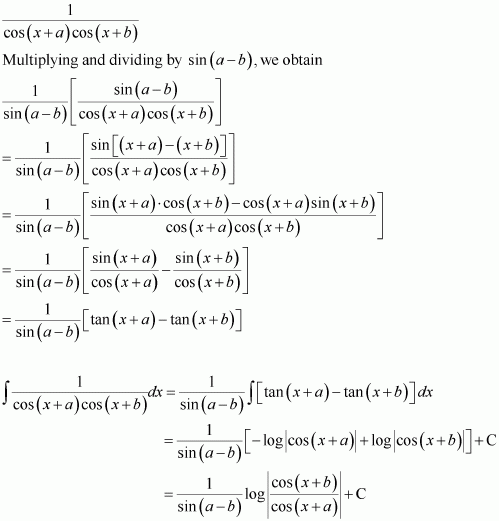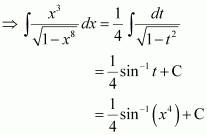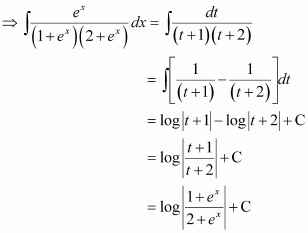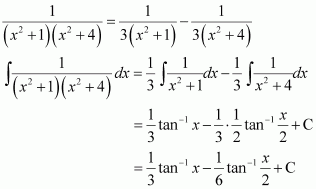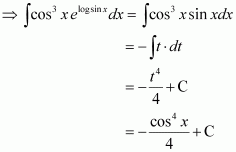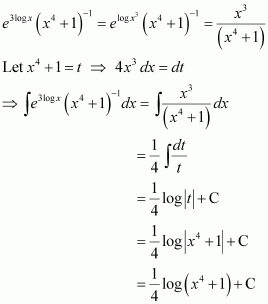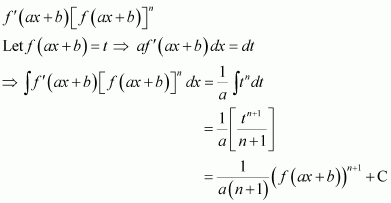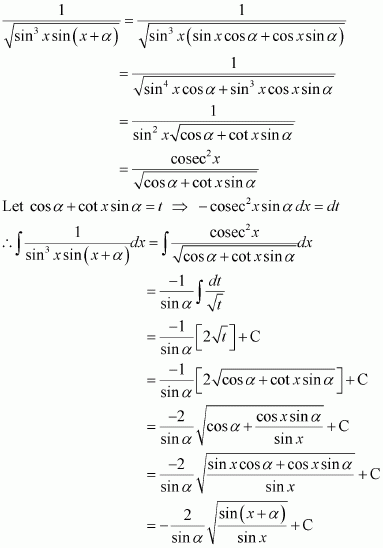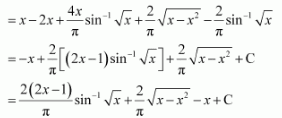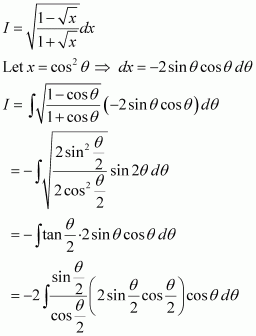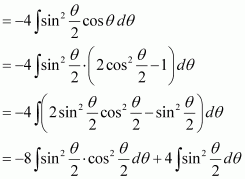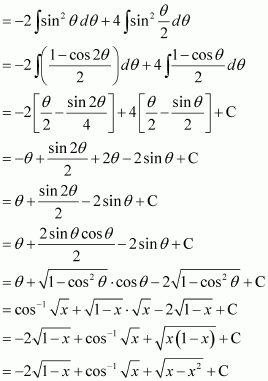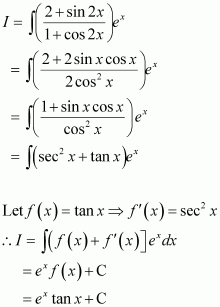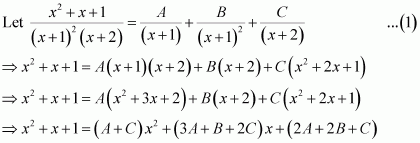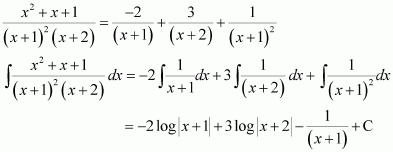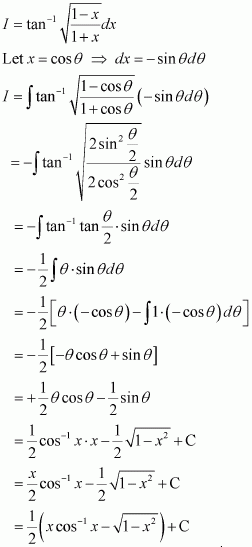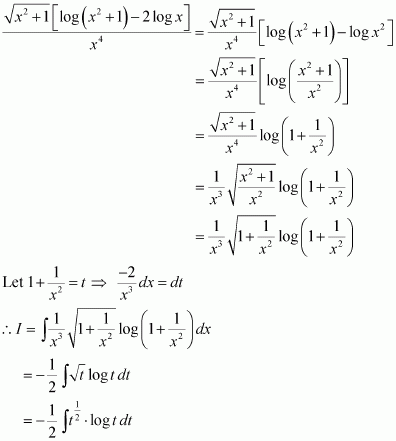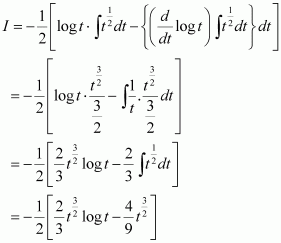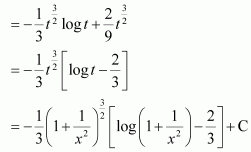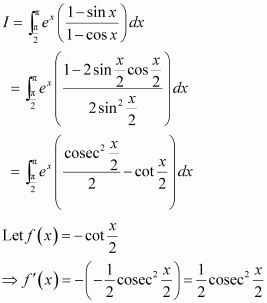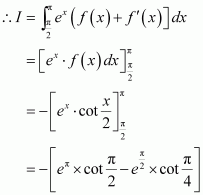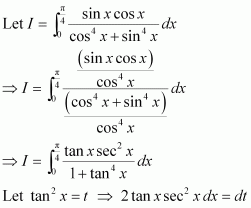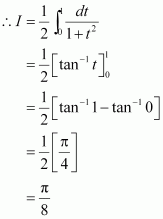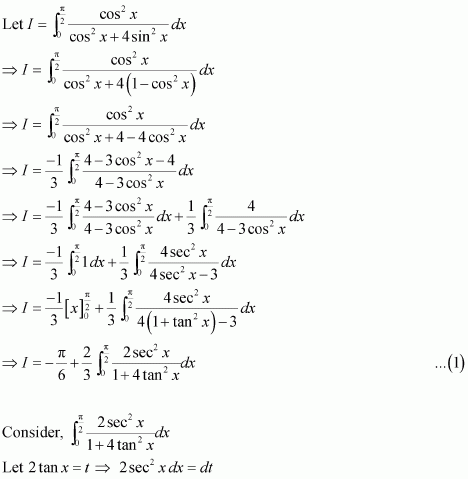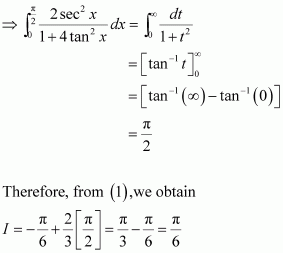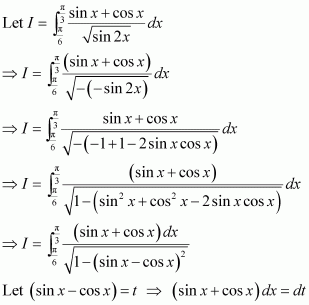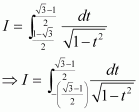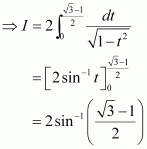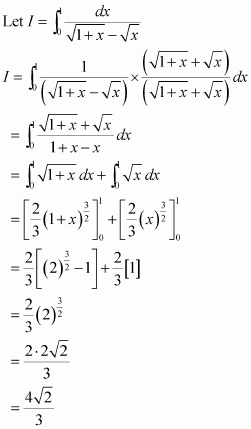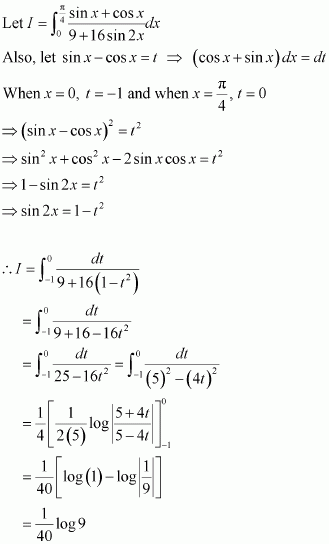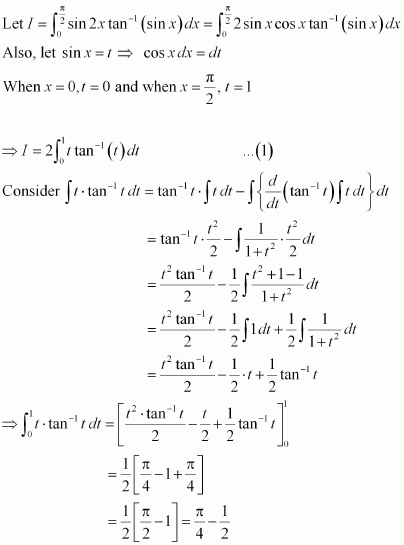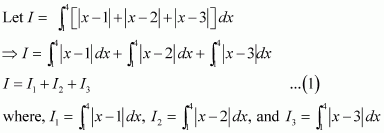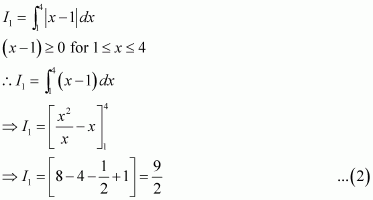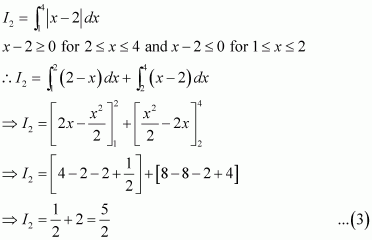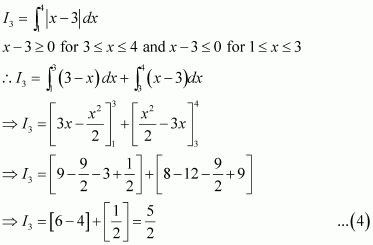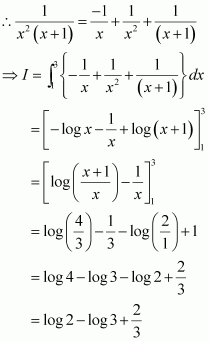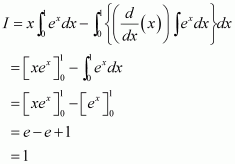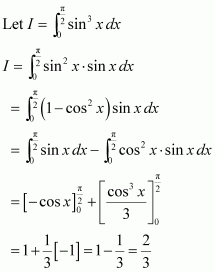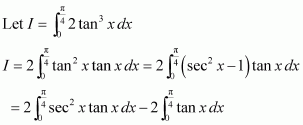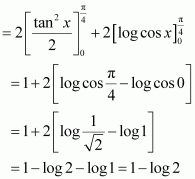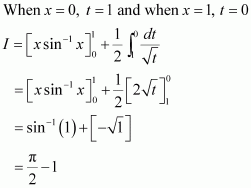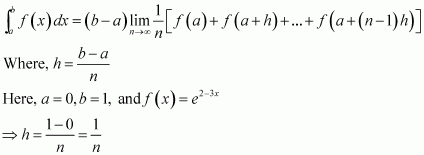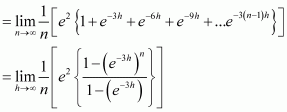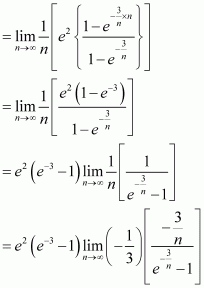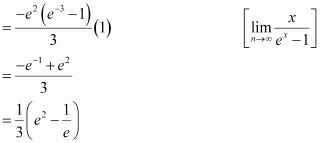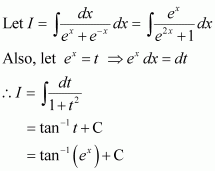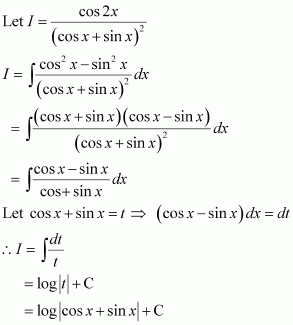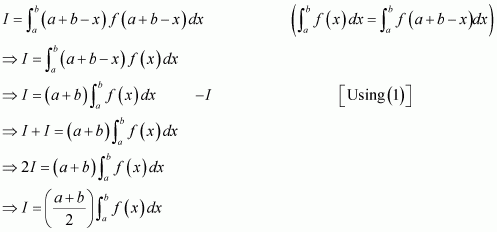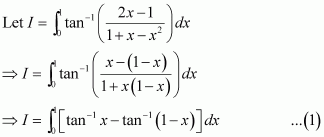Page No 299:
Question 1:
sin 2x
Answer:
The anti derivative of sin 2x is a function of x whose derivative is sin 2x.
It is known that,
Therefore, the anti derivative of
Question 2:
Cos 3x
Answer:
The anti derivative of cos 3x is a function of x whose derivative is cos 3x.
It is known that,
Therefore, the anti derivative of .
Question 3:
e2x
Answer:
The anti derivative of e2x is the function of x whose derivative is e2x.
It is known that,
Therefore, the anti derivative of .
Question 4:
Answer:
The anti derivative of
is the function of x whose derivative is
.
It is known that,
Therefore, the anti derivative of .
Question 5:
Answer:
The anti derivative of is the function of x whose derivative is
.
It is known that,
Therefore, the anti derivative of is
.
Question 6:
Answer:
Question 7:
Answer:
Question 8:
Answer:
Question 9:
Answer:
Question 10:
Answer:
Question 11:
Answer:
Question 12:
Answer:
Question 13:
Answer:
On dividing, we obtain
Question 14:
Answer:
Question 15:
Answer:
Question 16:
Answer:
Question 17:
Answer:
Question 18:
Answer:
Question 19:
Answer:
Question 20:
Answer:
Question 21:
The anti derivative of equals
(A) (B)
(C) (D)
Answer:
Hence, the correct answer is C.
Question 22:
If such that f(2) = 0, then f(x) is
(A) (B)
(C) (D)
Answer:
It is given that,
∴Anti derivative of
∴
Also,
Hence, the correct answer is A.
Page No 304:
Question 1:
Answer:
Let = t
∴2x dx = dt
Question 2:
Answer:
Let log |x| = t
∴
Question 3:
Answer:
Let 1 + log x = t
∴
Question 4:
sin x ⋅ sin (cos x)
Answer:
sin x ⋅ sin (cos x)
Let cos x = t
∴ −sin x dx = dt
Question 5:
Answer:
Let
∴ 2adx = dt
Question 6:
Answer:
Let ax + b = t
⇒ adx = dt
Question 7:
Answer:
Let
∴ dx = dt
Question 8:
Answer:
Let 1 + 2x2 = t
∴ 4xdx = dt
Question 9:
Answer:
Let
∴ (2x + 1)dx = dt
Question 10:
Answer:
Let
∴
Question 11:
Answer:
Let I=∫xx+4 dxput x+4=t⇒dx=dtNow, I=∫t-4tdt=∫t-4t-1/2dt=23t3/2-42t1/2+C=23.t.t1/2-8t1/2+C=23x+4x+4-8x+4+C=23xx+4+83x+4-8x+4+C=23xx+4-163x+4+C=23x+4x-8+C
Question 12:
Answer:
Let
∴
Question 13:
Answer:
Let
∴ 9x2 dx = dt
Question 14:
Answer:
Let log x = t
∴
Question 15:
Answer:
Let
∴ −8x dx = dt
Question 16:
Answer:
Let
∴ 2dx = dt
Question 17:
Answer:
Let
∴ 2xdx = dt
Page No 305:
Question 18:
Answer:
Let
∴
Question 19:
Answer:
Dividing numerator and denominator by ex, we obtain
Let
∴
Question 20:
Answer:
Let
∴
Question 21:
Answer:
Let 2x − 3 = t
∴ 2dx = dt
⇒∫tan22x-3dx = ∫sec22x-3 – 1dx=∫sec2t- 1dt2= 12∫sec2t dt – ∫1dt= 12tant – t + C= 12tan2x-3 – 2x-3 + C
Question 22:
Answer:
Let 7 − 4x = t
∴ −4dx = dt
Question 23:
Answer:
Let
∴
Question 24:
Answer:
Let
∴
Question 25:
Answer:
Let
∴
Question 26:
Answer:
Let
∴
Question 27:
Answer:
Let sin 2x = t
∴
Question 28:
Answer:
Let
∴ cos x dx = dt
Question 29:
cot x log sin x
Answer:
Let log sin x = t
Question 30:
Answer:
Let 1 + cos x = t
∴ −sin x dx = dt
Question 31:
Answer:
Let 1 + cos x = t
∴ −sin x dx = dt
Question 32:
Answer:
Let sin x + cos x = t ⇒ (cos x − sin x) dx = dt
Question 33:
Answer:
Put cos x − sin x = t ⇒ (−sin x − cos x) dx = dt
Question 34:
Answer:
Question 35:
Answer:
Let 1 + log x = t
∴
Question 36:
Answer:
Let
∴
Question 37:
Answer:
Let x4 = t
∴ 4x3 dx = dt
Let
∴
From (1), we obtain
Question 38:
equals
Answer:
Let
∴
Hence, the correct answer is D.
Question 39:
equals
A.
B.
C.
D.
Answer:
Hence, the correct answer is B.
Page No 307:
Question 1:
Answer:
Question 2:
Answer:
It is known that,
Question 3:
cos 2x cos 4x cos 6x
Answer:
It is known that,
Question 4:
sin3 (2x + 1)
Answer:
Let
Question 5:
sin3 x cos3 x
Answer:
Question 6:
sin x sin 2x sin 3x
Answer:
It is known that,
Question 7:
sin 4x sin 8x
Answer:
It is known that,
sin A . sin B = 12cosA-B-cosA+B∴∫sin4x sin8x dx=∫12cos4x-8x-cos4x+8xdx=12∫cos-4x-cos12xdx=12∫cos4x-cos12xdx=12sin4x4-sin12x12+C
Question 8:
Answer:
Question 9:
Answer:
Question 10:
sin4 x
Answer:
Question 11:
cos4 2x
Answer:
Question 12:
Answer:
Question 13:
Answer:
Question 14:
Answer:
Question 15:
Answer:
Question 16:
tan4x
Answer:
From equation (1), we obtain
Question 17:
Answer:
Question 18:
Answer:
Question 19:
Answer:
1sinxcos3x=sin2x+cos2xsinxcos3x=sinxcos3x+1sinxcosx
⇒1sinxcos3x=tanxsec2x+1cos2xsinxcosxcos2x=tanxsec2x+sec2xtanx
Question 20:
Answer:
Question 21:
sin−1 (cos x)
Answer:
It is known that,
Substituting in equation (1), we obtain
Question 22:
Answer:
Question 23:
is equal to
A. tan x + cot x + C
B. tan x + cosec x + C
C. − tan x + cot x + C
D. tan x + sec x + C
Answer:
Hence, the correct answer is A.
Question 24:

A. − cot (exx) + C
B. tan (xex) + C
C. tan (ex) + C
D. cot (ex) + C
Answer:
Let exx = t
Hence, the correct answer is B.
Page No 315:
Question 1:
Answer:
Let x3 = t
∴ 3x2 dx = dt
Question 2:
Answer:
Let 2x = t
∴ 2dx = dt
Question 3:
Answer:
Let 2 − x = t
⇒ −dx = dt
Question 4:
Answer:
Let 5x = t
∴ 5dx = dt
Question 5:
Answer:
Question 6:
Answer:
Let x3 = t
∴ 3x2 dx = dt
Question 7:
Answer:
From (1), we obtain
Question 8:
Answer:
Let x3 = t
⇒ 3x2 dx = dt
Question 9:
Answer:
Let tan x = t
∴ sec2x dx = dt
Page No 316:
Question 10:
Answer:
Question 11:
19×2+6x+5
Answer:
∫19×2+6x+5dx=∫13x+12+22dx
Let (3x+1)=t
∴
3 dx=dt
⇒∫13x+12+22dx=13∫1t2+22dt
=13×2tan-1t2+C
=16tan-13x+12+C
Question 12:
Answer:
Question 13:
Answer:
Question 14:
Answer:
Question 15:
Answer:
Question 16:
Answer:
Equating the coefficients of x and constant term on both sides, we obtain
4A = 4 ⇒ A = 1
A + B = 1 ⇒ B = 0
Let 2x2 + x − 3 = t
∴ (4x + 1) dx = dt
Question 17:
Answer:
Equating the coefficients of x and constant term on both sides, we obtain
From (1), we obtain
From equation (2), we obtain
Question 18:
Answer:
Equating the coefficient of x and constant term on both sides, we obtain
Substituting equations (2) and (3) in equation (1), we obtain
Question 19:
Answer:
Equating the coefficients of x and constant term, we obtain
2A = 6 ⇒ A = 3
−9A + B = 7 ⇒ B = 34
∴ 6x + 7 = 3 (2x − 9) + 34
Substituting equations (2) and (3) in (1), we obtain
Question 20:
Answer:
Equating the coefficients of x and constant term on both sides, we obtain
Using equations (2) and (3) in (1), we obtain
Question 21:
Answer:
Let x2 + 2x +3 = t
⇒ (2x + 2) dx =dt
Using equations (2) and (3) in (1), we obtain
Question 22:
Answer:
Equating the coefficients of x and constant term on both sides, we obtain
Substituting (2) and (3) in (1), we obtain
Question 23:
Answer:
Equating the coefficients of x and constant term, we obtain
Using equations (2) and (3) in (1), we obtain
Question 24:
equals
A. x tan−1 (x + 1) + C
B. tan− 1 (x + 1) + C
C. (x + 1) tan−1 x + C
D. tan−1 x + C
Answer:
Hence, the correct answer is B.
Question 25:
equals
A.
B.
C.
D.
Answer:
Hence, the correct answer is B.
Page No 322:
Question 1:
Answer:
Let
Equating the coefficients of x and constant term, we obtain
A + B = 1
2A + B = 0
On solving, we obtain
A = −1 and B = 2
Question 2:
Answer:
Let
Equating the coefficients of x and constant term, we obtain
A + B = 0
−3A + 3B = 1
On solving, we obtain
Question 3:
Answer:
Let
Substituting x = 1, 2, and 3 respectively in equation (1), we obtain
A = 1, B = −5, and C = 4
Question 4:
Answer:
Let
Substituting x = 1, 2, and 3 respectively in equation (1), we obtain
Question 5:
Answer:
Let
Substituting x = −1 and −2 in equation (1), we obtain
A = −2 and B = 4
Question 6:
Answer:
It can be seen that the given integrand is not a proper fraction.
Therefore, on dividing (1 − x2) by x(1 − 2x), we obtain
Let
Substituting x = 0 and in equation (1), we obtain
A = 2 and B = 3
Substituting in equation (1), we obtain
Question 7:
Answer:
Let
Equating the coefficients of x2, x, and constant term, we obtain
A + C = 0
−A + B = 1
−B + C = 0
On solving these equations, we obtain
From equation (1), we obtain
Question 8:
Answer:
Let
Substituting x = 1, we obtain
Equating the coefficients of x2 and constant term, we obtain
A + C = 0
−2A + 2B + C = 0
On solving, we obtain
Question 9:
Answer:
Let
Substituting x = 1 in equation (1), we obtain
B = 4
Equating the coefficients of x2 and x, we obtain
A + C = 0
B − 2C = 3
On solving, we obtain
Question 10:
Answer:
Let
Equating the coefficients of x2 and x, we obtain
Question 11:
Answer:
Let
Substituting x = −1, −2, and 2 respectively in equation (1), we obtain
Question 12:
Answer:
It can be seen that the given integrand is not a proper fraction.
Therefore, on dividing (x3 + x + 1) by x2 − 1, we obtain
Let
Substituting x = 1 and −1 in equation (1), we obtain
Question 13:
Answer:
Equating the coefficient of x2, x, and constant term, we obtain
A − B = 0
B − C = 0
A + C = 2
On solving these equations, we obtain
A = 1, B = 1, and C = 1
Question 14:
Answer:
Equating the coefficient of x and constant term, we obtain
A = 3
2A + B = −1 ⇒ B = −7
Question 15:
Answer:
Equating the coefficient of x3, x2, x, and constant term, we obtain
On solving these equations, we obtain
Question 16:
[Hint: multiply numerator and denominator by xn − 1 and put xn = t]
Answer:
Multiplying numerator and denominator by xn − 1, we obtain
Substituting t = 0, −1 in equation (1), we obtain
A = 1 and B = −1
Question 17:
[Hint: Put sin x = t]
Answer:
Substituting t = 2 and then t = 1 in equation (1), we obtain
A = 1 and B = −1
Page No 323:
Question 18:
Answer:
Equating the coefficients of x3, x2, x, and constant term, we obtain
A + C = 0
B + D = 4
4A + 3C = 0
4B + 3D = 10
On solving these equations, we obtain
A = 0, B = −2, C = 0, and D = 6
Question 19:
Answer:
Let x2 = t ⇒ 2x dx = dt
Substituting t = −3 and t = −1 in equation (1), we obtain
Question 20:
Answer:
Multiplying numerator and denominator by x3, we obtain
Let x4 = t ⇒ 4x3dx = dt
Substituting t = 0 and 1 in (1), we obtain
A = −1 and B = 1
Question 21:
[Hint: Put ex = t]
Answer:
Let ex = t ⇒ ex dx = dt
Substituting t = 1 and t = 0 in equation (1), we obtain
A = −1 and B = 1
Question 22:
A.
B.
C.
D.
Answer:
Substituting x = 1 and 2 in (1), we obtain
A = −1 and B = 2
Hence, the correct answer is B.
Question 23:
A.
B.
C.
D.
Answer:
Equating the coefficients of x2, x, and constant term, we obtain
A + B = 0
C = 0
A = 1
On solving these equations, we obtain
A = 1, B = −1, and C = 0
Hence, the correct answer is A.
Page No 327:
Question 1:
x sin x
Answer:
Let I =
Taking x as first function and sin x as second function and integrating by parts, we obtain
Question 2:
Answer:
Let I =
Taking x as first function and sin 3x as second function and integrating by parts, we obtain
Question 3:
Answer:
Let
Taking x2 as first function and ex as second function and integrating by parts, we obtain
Again integrating by parts, we obtain
Question 4:
x logx
Answer:
Let
Taking log x as first function and x as second function and integrating by parts, we obtain
Question 5:
x log 2x
Answer:
Let
Taking log 2x as first function and x as second function and integrating by parts, we obtain
Question 6:
x2 log x
Answer:
Let
Taking log x as first function and x2 as second function and integrating by parts, we obtain
Question 7:
Answer:
Let
Taking as first function and x as second function and integrating by parts, we obtain
Question 8:
Answer:
Let
Taking as first function and x as second function and integrating by parts, we obtain
Question 9:
Answer:
Let
Taking cos−1 x as first function and x as second function and integrating by parts, we obtain
Question 10:
Answer:
Let
Taking as first function and 1 as second function and integrating by parts, we obtain
Question 11:
Answer:
Let
Taking as first function and

Question 12:
Answer:
Let
Taking x as first function and sec2x as second function and integrating by parts, we obtain
Question 13:
Answer:
Let
Taking as first function and 1 as second function and integrating by parts, we obtain
Question 14:
Answer:
Taking as first function and x as second function and integrating by parts, we obtain
I=log x 2∫xdx-∫ddxlog x 2∫xdxdx=x22log x 2-∫2log x .1x.x22dx=x22log x 2-∫xlog x dx
Again integrating by parts, we obtain
I = x22logx 2-log x ∫x dx-∫ddxlog x ∫x dxdx=x22logx 2-x22log x -∫1x.x22dx=x22logx 2-x22log x +12∫x dx=x22logx 2-x22log x +x24+C
Question 15:
Answer:
Let
Let I = I1 + I2 … (1)
Where, and
Taking log x as first function and x2 as second function and integrating by parts, we obtain
Taking log x as first function and 1 as second function and integrating by parts, we obtain
Using equations (2) and (3) in (1), we obtain
Page No 328:
Question 16:
Answer:
Let
Let
⇒
∴
It is known that,
Question 17:
Answer:
Let
Let ⇒
It is known that,
Question 18:
Answer:
Let ⇒
It is known that,
From equation (1), we obtain
Question 19:
Answer:
Also, let ⇒
It is known that,
Question 20:
Answer:
Let ⇒
It is known that,
Question 21:
Answer:
Let
Integrating by parts, we obtain
Again integrating by parts, we obtain
Question 22:
Answer:
Let ⇒
= 2θ
⇒
Integrating by parts, we obtain
Question 23:
equals
Answer:
Let
Also, let ⇒
Hence, the correct answer is A.
Question 24:
equals
Answer:
Let
Also, let ⇒
It is known that,
Hence, the correct answer is B.
Page No 330:
Question 1:
Answer:
Question 2:
Answer:
Question 3:
Answer:
Question 4:
Answer:
Question 5:
Answer:
Question 6:
Answer:
Question 7:
Answer:
Question 8:
Answer:
Question 9:
Answer:
Question 10:
is equal to
A.
B.
C.
D.
Answer:
Hence, the correct answer is A.
Question 11:
is equal to
A.
B.
C.
D.
Answer:
Hence, the correct answer is D.
Page No 334:
Question 1:
Answer:
It is known that,
Question 2:
Answer:
It is known that,
Question 3:
Answer:
It is known that,
Question 4:
Answer:
It is known that,
From equations (2) and (3), we obtain
Question 5:
Answer:
It is known that,
Question 6:
Answer:
It is known that,
Page No 338:
Question 1:
Answer:
By second fundamental theorem of calculus, we obtain
Question 2:
Answer:
By second fundamental theorem of calculus, we obtain
Question 3:
Answer:
By second fundamental theorem of calculus, we obtain
Question 4:
Answer:
By second fundamental theorem of calculus, we obtain
Question 5:
Answer:
By second fundamental theorem of calculus, we obtain
Question 6:
Answer:
By second fundamental theorem of calculus, we obtain
Question 7:
Answer:
By second fundamental theorem of calculus, we obtain
Question 8:
Answer:
By second fundamental theorem of calculus, we obtain
Question 9:
Answer:
By second fundamental theorem of calculus, we obtain
Question 10:
Answer:
By second fundamental theorem of calculus, we obtain
Question 11:
Answer:
By second fundamental theorem of calculus, we obtain
Question 12:
Answer:
By second fundamental theorem of calculus, we obtain
Question 13:
Answer:
By second fundamental theorem of calculus, we obtain
Question 14:
Answer:
By second fundamental theorem of calculus, we obtain
Question 15:
Answer:
By second fundamental theorem of calculus, we obtain
Question 16:
Answer:
Let
Equating the coefficients of x and constant term, we obtain
A = 10 and B = −25
Substituting the value of I1 in (1), we obtain
Question 17:
Answer:
By second fundamental theorem of calculus, we obtain
Question 18:
Answer:
By second fundamental theorem of calculus, we obtain
Question 19:
Answer:
By second fundamental theorem of calculus, we obtain
Question 20:
Answer:
By second fundamental theorem of calculus, we obtain
Question 21:
equals
A.
B.
C.
D.
Answer:
By second fundamental theorem of calculus, we obtain
Hence, the correct answer is D.
Question 22:
equals
A.
B.
C.
D.
Answer:
By second fundamental theorem of calculus, we obtain
Hence, the correct answer is C.
Page No 340:
Question 1:
Answer:
When x = 0, t = 1 and when x = 1, t = 2
Question 2:
Answer:
Also, let
Question 3:
Answer:
Also, let x = tanθ ⇒ dx = sec2θ dθ
When x = 0, θ = 0 and when x = 1,
Takingθas first function and sec2θ as second function and integrating by parts, we obtain
Question 4:
Answer:
Let x + 2 = t2 ⇒ dx = 2tdt
When x = 0, and when x = 2, t = 2
Question 5:
Answer:
Let cos x = t ⇒ −sinx dx = dt
When x = 0, t = 1 and when
Question 6:
Answer:
Let ⇒ dx = dt
Question 7:
Answer:
Let x + 1 = t ⇒ dx = dt
When x = −1, t = 0 and when x = 1, t = 2
Question 8:
Answer:
Let 2x = t ⇒ 2dx = dt
When x = 1, t = 2 and when x = 2, t = 4
Question 9:
The value of the integral 
A. 6
B.
C. 3
D. 4
Answer:
Let cotθ = t ⇒ −cosec2θ dθ= dt
Hence, the correct answer is A.
Question 10:
If
A. cos x + x sin x
B. x sin x
C. x cos x
D. sin x + x cos x
Answer:
Integrating by parts, we obtain
Hence, the correct answer is B.
Page No 347:
Question 1:
Answer:
Adding (1) and (2), we obtain
Question 2:
Answer:
Adding (1) and (2), we obtain
Question 3:
Answer:
Adding (1) and (2), we obtain
Question 4:
Answer:
Adding (1) and (2), we obtain
Question 5:
Answer:
It can be seen that (x + 2) ≤ 0 on [−5, −2] and (x + 2) ≥ 0 on [−2, 5].
Question 6:
Answer:
It can be seen that (x − 5) ≤ 0 on [2, 5] and (x − 5) ≥ 0 on [5, 8].
Question 7:
Answer:
Question 8:
Answer:
Question 9:
Answer:
Question 10:
Answer:
Adding (1) and (2), we obtain
Question 11:
Answer:
As sin2 (−x) = (sin (−x))2 = (−sin x)2 = sin2x, therefore, sin2x is an even function.
It is known that if f(x) is an even function, then
Question 12:
Answer:
Adding (1) and (2), we obtain
Question 13:
Answer:
As sin7 (−x) = (sin (−x))7 = (−sin x)7 = −sin7x, therefore, sin2x is an odd function.
It is known that, if f(x) is an odd function, then
Question 14:
Answer:
It is known that,
Question 15:
Answer:
Adding (1) and (2), we obtain
Question 16:
Answer:
Adding (1) and (2), we obtain
sin (π − x) = sin x
Adding (4) and (5), we obtain
Let 2x = t ⇒ 2dx = dt
When x = 0, t = 0 and when
x=π2, t=π∴
I=12∫0πlog sin tdt-π2log 2
⇒I=I2-π2log 2 [from 3]
⇒I2=-π2log 2
⇒I=-πlog 2
Question 17:
Answer:
It is known that,
Adding (1) and (2), we obtain
Question 18:
Answer:
It can be seen that, (x − 1) ≤ 0 when 0 ≤ x ≤ 1 and (x − 1) ≥ 0 when 1 ≤ x ≤ 4
Question 19:
Show that if f and g are defined as
and
Answer:
Adding (1) and (2), we obtain
Question 20:
The value of is
A.
B. 2
C. π
D. 1
Answer:
It is known that if f(x) is an even function, then and
if f(x) is an odd function, then
Hence, the correct answer is C.
Question 21:
The value of is
A. 2
B.
C. 0
D.
Answer:
Adding (1) and (2), we obtain
Hence, the correct answer is C.
Page No 352:
Question 1:
Answer:
Equating the coefficients of x2, x, and constant term, we obtain
−A + B − C = 0
B + C = 0
A = 1
On solving these equations, we obtain
From equation (1), we obtain
Question 2:
Answer:
Question 3:
[Hint: Put
]
Answer:
Question 4:
Answer:
Question 5:

Answer:
On dividing, we obtain
Question 6:
Answer:
Equating the coefficients of x2, x, and constant term, we obtain
A + B = 0
B + C = 5
9A + C = 0
On solving these equations, we obtain
From equation (1), we obtain
Question 7:
Answer:
Let x − a = t ⇒ dx = dt
Question 8:
Answer:
Question 9:
Answer:
Let sin x = t ⇒ cos x dx = dt
Question 10:
Answer:
Question 11:
Answer:
Question 12:
Answer:
Let x4 = t ⇒ 4x3 dx = dt
Question 13:
Answer:
Let ex = t ⇒ ex dx = dt
Question 14:
Answer:
Equating the coefficients of x3, x2, x, and constant term, we obtain
A + C = 0
B + D = 0
4A + C = 0
4B + D = 1
On solving these equations, we obtain
From equation (1), we obtain
Question 15:
Answer:
= cos3 x × sin x
Let cos x = t ⇒ −sin x dx = dt
Question 16:
Answer:
Question 17:
Answer:
Question 18:
Answer:
Question 19:
Answer:
Let I=∫sin-1x-cos-1xsin-1x+cos-1xdx
It is known that, sin-1x+cos-1x=π2
⇒I=∫π2-cos-1x-cos-1xπ2dx
=2π∫π2-2cos-1xdx
=2π.π2∫1.dx-4π∫cos-1xdx
=x-4π∫cos-1xdx …(1)
Let I1=∫cos-1x dx
Also, let x=t⇒dx=2 t dt
⇒I1=2∫cos-1t.t dt
=2cos-1t.t22-∫-11-t2.t22dt
=t2cos-1t+∫t21-t2dt
=t2cos-1t-∫1-t2-11-t2dt
=t2cos-1t-∫1-t2dt+∫11-t2dt
=t2cos-1t-t21-t2-12sin-1t+sin-1t
=t2cos-1t-t21-t2+12sin-1t
From equation (1), we obtain
I=x-4πt2cos-1t-t21-t2+12sin-1t =x-4πxcos-1x-x21-x+12sin-1x
=x-4πxπ2-sin-1x-x-x22+12sin-1x
Question 20:
Answer:
Question 21:
Answer:
Question 22:
Answer:
Equating the coefficients of x2, x,and constant term, we obtain
A + C = 1
3A + B + 2C = 1
2A + 2B + C = 1
On solving these equations, we obtain
A = −2, B = 1, and C = 3
From equation (1), we obtain
Page No 353:
Question 23:
Answer:
Question 24:
Answer:
Integrating by parts, we obtain
Question 25:
Answer:
Question 26:
Answer:
When x = 0, t = 0 and
Question 27:
Answer:
When and when
Question 28:
Answer:
When
As 
is an even function.
It is known that if f(x) is an even function, then
Question 29:
Answer:
Question 30:
Answer:
Question 31:
Answer:
From equation (1), we obtain
Question 32:
Answer:
Adding (1) and (2), we obtain
Question 33:
Answer:
From equations (1), (2), (3), and (4), we obtain
Question 34:
Answer:
Equating the coefficients of x2, x, and constant term, we obtain
A + C = 0
A + B = 0
B = 1
On solving these equations, we obtain
A = −1, C = 1, and B = 1
Hence, the given result is proved.
Question 35:
Answer:
Integrating by parts, we obtain
Hence, the given result is proved.
Question 36:
Answer:
Therefore, f (x) is an odd function.
It is known that if f(x) is an odd function, then
Hence, the given result is proved.
Question 37:
Answer:
Hence, the given result is proved.
Question 38:
Answer:
Hence, the given result is proved.
Question 39:
Answer:
Integrating by parts, we obtain
Let 1 − x2 = t ⇒ −2x dx = dt
Hence, the given result is proved.
Question 40:
Evaluate as a limit of a sum.
Answer:
It is known that,
Question 41:
is equal to
A.
B.
C.
D.
Answer:
Hence, the correct answer is A.
Question 42:
is equal to
A.
B.
C.
D.
Answer:
Hence, the correct answer is B.
Page No 354:
Question 43:
If then
is equal to
A.
B.
C.
D.
Answer:
Hence, the correct answer is D.
Question 44:
The value of is
A. 1
B. 0
C. − 1
D.
Answer:
Adding (1) and (2), we obtain
Hence, the correct answer is B.
